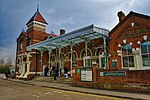Leatherhead is a town in the Mole Valley district of Surrey, England, about 17 mi (27 km) south of Central London. The settlement grew up beside a ford on the River Mole, from which its name is thought to derive. During the late Anglo-Saxon period, Leatherhead was a royal vill and is first mentioned in the will of Alfred the Great in 880 AD. The first bridge across the Mole may have been constructed in around 1200 and this may have coincided with the expansion of the town and the enlargement of the parish church.
For much of its history, Leatherhead was primarily an agricultural settlement, with a weekly market being held until the mid-Elizabethan era. The construction of turnpike roads in the mid-18th century and the arrival of the railways in the second half of the 19th century attracted newcomers and began to stimulate the local economy. Large-scale manufacturing industries arrived following the end of the First World War and companies with factories in the town included Ronson and Goblin Vacuum Cleaners. Several organisations working with disabled people also opened treatment and training facilities, including The Royal School for the Blind, Queen Elizabeth's Foundation and the Ex-services Welfare Society.
Towards the end of the 20th century, manufacturing in Leatherhead had begun to decline and the town was instead starting to attract service sector employers. The former industrial areas were converted to business parks, which attracted multinational companies, including Esso and Unilever. A controversial redevelopment took place in the town centre in the early 1980s, which included the construction of the Swan Centre. The work, which also included the pedestrianisation of the main shopping area, was widely blamed for a decline in the local retail economy. In 2002, the BBC identified Leatherhead as having one of the worst High Streets in England, but in 2007, the local press described the town centre as "bustling".










